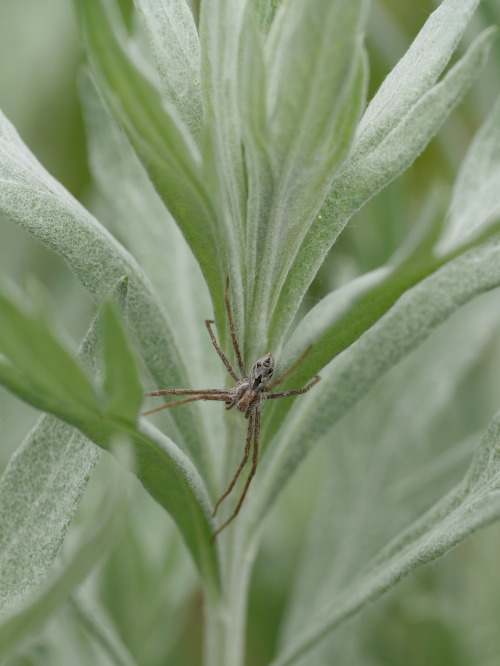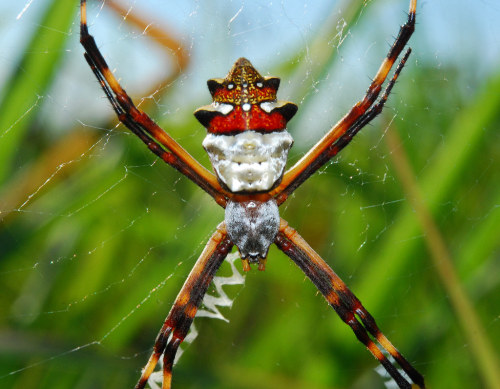#arachnida
Oxyopes scalaris “Western Lynx Spider” Oxyopidae
Missoula, MT
May 6, 2016
Robert Niese
Lynx spiders are some of my favorite arachnids! They’re stealthy, fast, agile and ferocious predators, some of which specialize on other spiders! Oxyopes scalaris is virtually the only species of lynx found in the PNW, however. It can be found in just about any habitat from the coast to the Rockies and as far north as BC. One additional species, the Striped Lynx (O. salticus) can be found along the coast from California through Oregon and, rarely, in southern Washington.
Post link
Philodromus histrio “Theatrical Running Crab Spider” Philodromidae
Blue Mountain National Recreation Area, MT
May 16, 2016
Robert Niese
I have no idea why this species of running crab spider has been given the species epithet “histrio.” In Latin, histriomeans “actor” or “player.” Perhaps the arachnid’s propensity for waving its arms about whenever a predator (or camera) approaches earned it this descriptor. Or perhaps some early entomologist first encountered it engaged in an impressive act of twig-impersonation. In fact, when I first stumbled upon this individual, its legs were perfectly aligned in the shape of an X and pressed flat against the underside of this Artemisiastem, perhaps hoping to be mistaken for plant matter. Regardless, these Philodromids are widespread, common, and relatively recognizable. Look for them in northern latitudes and in the Rockies anywhere you might find weedy Asteraceous plants like Artemisia,Tanacetum,Centaurea, or Senicio (yes, I know, that encompasses just about every habitat).
Post link

Bug of the Day - Arachtober!
This common pirate spider (Mimetus puritanus) set up shop by one of my bug lights this past summer. ID via iNat

Bug of the Day - Arachtober!
Found this fairly creepy-looking wolf spider on the wall next to my porch light. Thx to Aaron McKee for identifying this as Allocosa funerea.

Bug of the Day - Arachtober!
I thought for sure that an id was out of the question on this cobweb spider, because I only caught a shot of the underside, but it turns out that the shape of the epigyne (external genital structure on females, which is what you probably guessed it was from the name ;-)) is an id character for this species, which Aaron McKee helpfully pointed out is Steatoda borealis.

Bug of the Day - Arachtober!
Gotta admire the gumption of this tiny running crab spider (Philodromus sp.), taking down a midge with a body more than twice the length of it!
(Thx to Aaron McKee for identifying this as a running crab spider)


Bug of the Day - Arachtober!
This nursery web spider (Pisaurina mira) has captured a most delicious meal!

Bug of the Day - Arachtober!
Are you enjoying Arachtober so far? This fancy dimorphic jumping spider (Maevia inclemens) sure is! Thx to Aaron McKee for the id.

Bug of the Day - Arachtober!
Check out the coloring on this metallic crab spider (Philodromus marxi)! It looks like an Xmas ornament!

Bug of the Day - Arachtober!
This cute and super fast spider was identified over at iNat as a Two-banded Ant-mimic Sac Spider, Castianeira cingulata. It’s got something delicious it is clinging to but its prey was too small for me to id.

Bug of the Day - Arachtober!
This cobweb spider (I think) was quite intent on sucking the life out of the leafhopper it snagged. From the side of my house near a light, last July :-).

Bug of the Day - Arachtober!
This jumping spider (tan jumping spider, Platycryptus undatus) was nomming on something delicious it grabbed off the moth sheet last July.

Bug of the Day - Arachtober!
Happy Arachtober 1st! For those of you not familiar with Arachtober, it’s all arachnids, all month! Mainly spiders for me. Enjoy!
This appears to be a Theridid spider, possibly the adorably-named common candy-striped spider, Enoplognatha ovata.




